In video games, a power-up is an object that adds temporary benefits or extra abilities to the player character as a game mechanic. This is in contrast to an item, which may or may not have a permanent benefit that can be used at any time chosen by the player. Although often collected directly through touch, power-ups can sometimes only be gained by collecting several related items, such as the floating letters of the word 'EXTEND' in Bubble Bobble. Well known examples of power-ups that have entered popular culture include the power pellets from Pac-Man and the Super Mushroom from Super Mario Bros., which ranked first in UGO Networks' Top 11 Video Game Powerups.
An action game is a video game genre that emphasizes physical challenges, including hand–eye coordination and reaction time. The genre includes a large variety of sub-genres, such as fighting games, beat 'em ups, shooter games, rhythm games and platform games. Multiplayer online battle arena and some real-time strategy games are also considered action games.
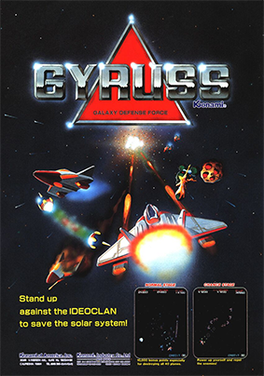
Gyruss is shoot 'em up arcade video game designed by Yoshiki Okamoto and released by Konami in 1983. Gyruss was initially licensed to Centuri in the United States for dedicated machines, before Konami released their own self-distributed conversion kits for the game. Parker Brothers released contemporary ports for home systems. An enhanced version for the Family Computer Disk System was released in 1988, which was released to the North American Nintendo Entertainment System in early 1989.

Replay value is the potential of a video game or other media products for continued play value after its first completion. Factors that can influence perceived replay value include the game's extra characters, secrets and alternate endings. The replay value of a game may also be based entirely on the individual's tastes. A player might enjoy repeating a game because of the music, graphics, gameplay or because of product loyalty. Dynamic environments, challenging AI, a wide variety of ways to accomplish tasks, and a rich array of assets could result in a high replay value.
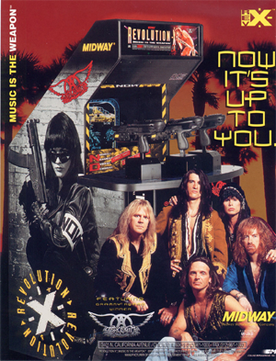
Revolution X is a shooting gallery video game developed by Midway and released in arcades in 1994. The gameplay is similar to Midway's earlier Terminator 2: Judgment Day, but is themed around the band Aerosmith. The oppressive New Order Nation regime and their leader Helga have abducted Aerosmith, and players use a mounted gun to control onscreen crosshairs and shoot enemies. The members of Aerosmith are hidden throughout the game's international locales and must be found in order to receive the game's true ending.

Tyrian is a vertically scrolling shooter developed by Eclipse Software for MS-DOS and published in 1995 by Epic MegaGames. Tyrian was programmed by Jason Emery, illustrated by Daniel Cook, and its music composed by Alexander Brandon and Andras Molnar. The game was re-released as freeware in 2004. A free and open-source port of the game started in April 2007.

Pac-Man World 2 is a video game by Namco USA for the Xbox, GameCube, and PlayStation 2, released in 2002. A version of the game for Microsoft Windows was released in 2004, and an isometric sidescroller was made for the Game Boy Advance in 2005. The game is a sequel to Pac-Man World (1999). The game is a platform game, where the player controls Pac-Man in a 3D platforming environment, through six worlds. In 2005, a sequel, Pac-Man World 3, was released.

In video games, a level is any space available to the player during the course of completion of an objective. Video game levels generally have progressively increasing difficulty to appeal to players with different skill levels. Each level may present new concepts and challenges to keep a player's interest high.
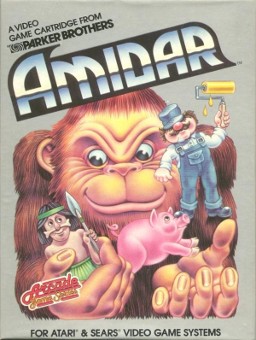
Amidar is a video game developed by Konami and released in arcades in 1981 by Stern. The format is similar to that of Pac-Man: the player moves around a fixed rectilinear lattice, attempting to visit each location on the board while avoiding the enemies. When each spot has been visited, the player moves to the next level. The game and its name have their roots in the Japanese lot drawing game Amidakuji. The bonus level in Amidar is a nearly exact replication of an Amidakuji game and the way the enemies move conform to the Amidakuji rules; this is referred to in the attract mode as "Amidar movement."

Operation Neptune is an educational computer game produced in 1991 by The Learning Company. The goal of the game is to guide a small submarine through a variety of undersea caverns, collecting pieces of a ruined space capsule. Like other games by The Learning Company, Operation Neptune is educational and was intended for players age nine to fourteen. It was released as part of the Super Solvers series for a time.

Bomberman Jetters is an action game for the Game Boy Advance, GameCube and PlayStation 2, and part of Hudson Soft's Bomberman series. The game builds on the gameplay style established in the previous Bomberman series entry, 2002's Bomberman Generation, and features characters and settings from the 2002 anime series Bomberman Jetters. The GameCube version utilizes cel-shaded graphics similar to those of Bomberman Generation, while the PlayStation 2 version does not.
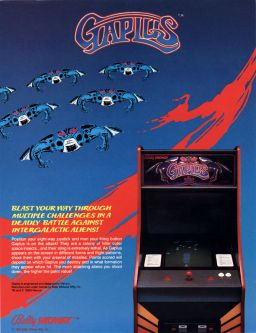
Gaplus is a 1984 fixed shooter arcade game developed and released by Namco. It is the third game in the Galaxian series, serving as a direct sequel to Galaga (1981). In North America, a modification kit was later released to change the name to Galaga 3, possibly to reflect its position in the series. It was the only game other than Phozon to run on the Namco Phozon hardware. A contemporary home port for the Commodore 64 was released in 1988. A "demastered" version of the game was included in Namco Museum Archives Vol. 2 as a bonus title.
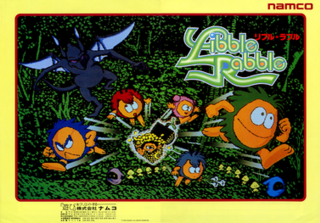
Libble Rabble is a 1983 puzzle arcade video game developed and published in Japan by Namco. The player is tasked with using two colored arrows, Libble and Rabble, to wrap them around pegs and surround small creatures known as Mushlins to "harvest" them under a time limit. The player can also uncover treasure chests that will have the player searching the stage for items in order to access a special bonus stage. It ran on the Namco Libble Rabble hardware, one of the only games to do so.

Zuma is a 2003 tile-matching puzzle video game developed by Oberon Media and published by PopCap Games. It was released for a number of platforms, including PDAs, mobile phones, and the iPod.

Do! Run Run, also known as Super Pierrot, is the fourth and final incarnation of Mr. Do!, the Universal video game mascot. Returning to his Mr. Do! roots, the clown has a bouncing powerball with which to hurl at monsters. Mr. Do runs along the playfield picking up dots and leaving a line behind him, which the player is encouraged to create closed off sections with. Precariously balanced log traps can be rolled downslope, crushing enemies. The resulting game is something of a cross between Mr. Do!, Congo Bongo, Pac-Man, and Qix.

Mappy-Land is a video game console-only sequel to the 1983 Namco/Midway arcade game Mappy. The game was developed by TOSE and published by Namco in Japan and Taxan in North America for the Nintendo Entertainment System. It was later released by Bandai Namco Entertainment for the Wii U Virtual Console worldwide in February 2015, and on the Nintendo Switch Online Service in March 2022.
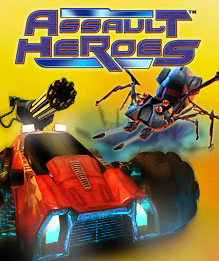
Assault Heroes is an arcade-style, top-down shooter video game developed by Wanako Games. The game has the player driving 4x4 vehicles, piloting speedboats, or proceeding on foot against enemy hordes. Players can play alone or co-operatively, including both online and offline 2-player co-operative modes.

Luxor Evolved is a tile-matching video game released in 2012 by MumboJumbo. Similarly to what PopCap Games had done when putting out a sequel to Zuma three years earlier, Luxor Evolved was a complete visual and design refresh of the Luxor series, taking the previous titles' staple Ancient Egypt thematics and combining them with a retro video game aesthetic, aiming to lure players in with eye-catching visual detail. This title is the last fully original game of the series.
This is a non-comprehensive list that includes terms used in video games and the video game industry, as well as slang used by players.

In video games, a life is a play-turn that a player character has, defined as the period between start and end of play. Lives refer to a finite number of tries before the game ends with a game over. It is sometimes called a chance, a try, rest or a continue particularly in all-ages games, to avoid the morbid insinuation of losing one's "life". Generally, if the player loses all their health, they lose a life. Losing all lives usually grants the player character "game over", forcing them to either restart or stop playing.
















